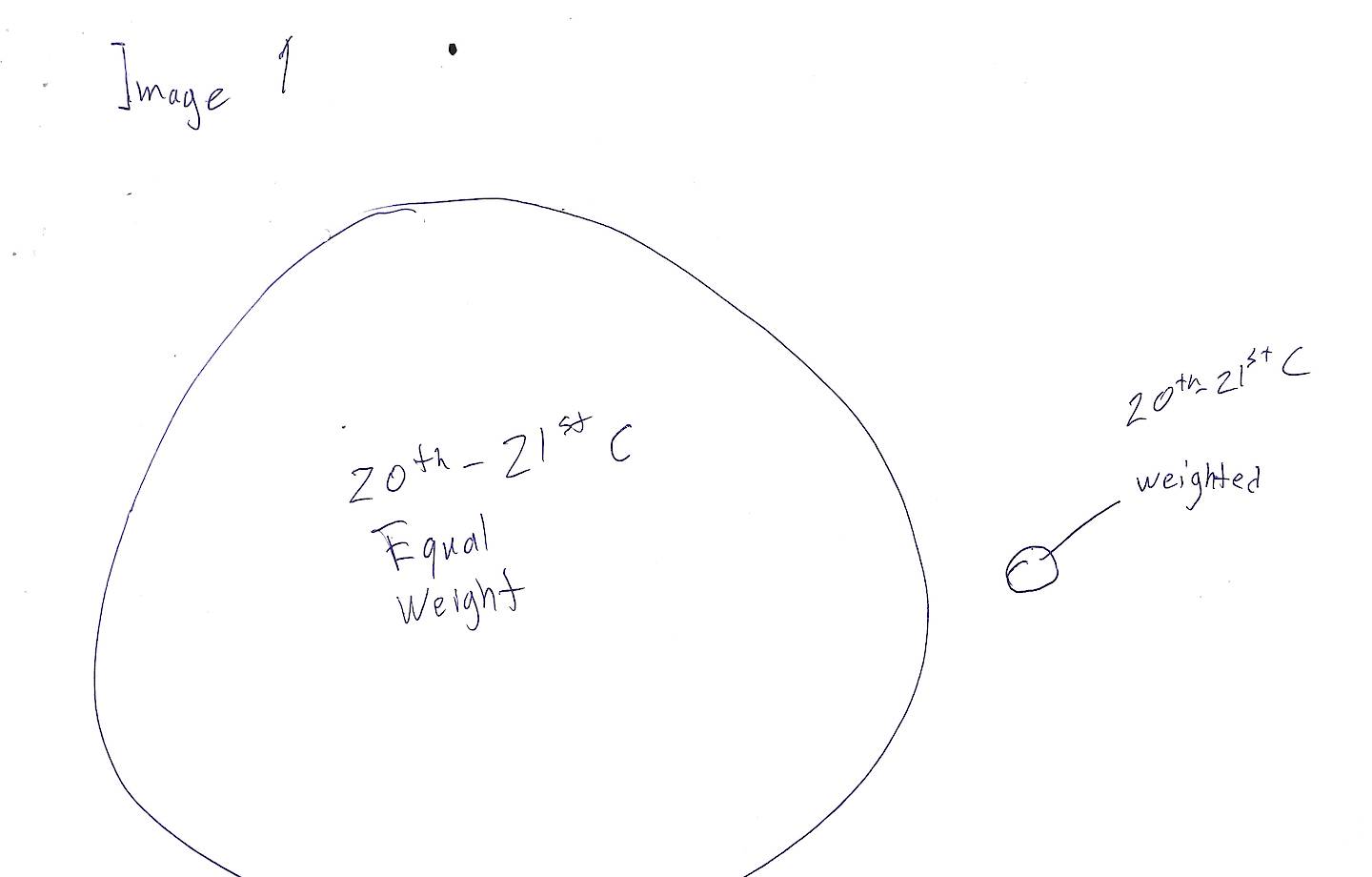Equal Weight and the Hardness of Collection Boundaries
Every few years I come back to this discussion. The first time I brought it up it was like throwing a pebble into the Grand Canyon. But I persist. This is reductionistic; this is a gloss. Don't lean on it too hard on it.

I need to look up the details, but I remember Boulez & Leibowitz issuing a diktat:
Paraphrasing -- We shall consider music of 12 tones with equal weight and the rest we willl dismiss.
Webern was elevated over Schoenberg. Schoenberg's neoclassicism and neo-romanticism were not at all in conformity with *equal weight*.
Milton Babbitt, at a lunch with me and a guitarist from Montreal (Otto Joaquim's son), explained that he is a Schoenbergite. In many other conversations he also avowed an interest in prolongation and Schenker. His favorite composer was Brahms. Sessions sent him to Europe to find living Schenkerians after WWII. Brahms was Babbitt's favorite composer.
[True, for Babbitt & Schoenberg, interval content within a focal hexachord sometimes gets equal weight? That's to say, sometimes the entire hexachord is focal? And nevertheless, Babbitt loved to land on trichordal signatures of his focal hexachord and sometimes he lands hard on those. There's usually a displacement, a nice progression of trichords over a mid-range time span, weighted. Schoenberg op. 29 has many textures that float beautifully without bumps. Op. 9 is an axiomatic treatment of the intereval cycles, each presented in discrete themes; Babbitt made this point at his 90th birthday concert at Merkin.]
These things rubbed of on me through my falling in with Princetonians, especially Babbit, Frank Brickle, Robert Pollock, Claudio Spies, Rolf Yttrehus, Ben Boretz, but also David Del Tredici.
What is equal weight? It's less bumpy. Unequal weight comes from the hardness of collection boundaries. In a chord chart, each chord change is a little bump. A chromaticism is harder bump. A chromaticism with an enharmonic element is harder still. Beethoven's sforzandos are motivated by big and bigger chromaticisms.
Perotin to Machaut is overwhelmingly equal weight and no surprise that Steve Reich owned his kinship with Perotin. Putting this another way, collection boundaries are soft in Perotin. We do hear them, especially when the slow moving bass line lands on the 4th scale degree, rendering Lydian above. That's a Perotin collection boundary and a Steve Reich collection boundary (see/hear mvt. 2 of Electric Counterpoint). What is above the bass may be harmonically static.
Image 2: Perhaps the point here is diversity vs. the herd falling into a narrow rut--

--Machaut's Lydian moves are still soft, but they begin to mark phrase endings? I leave that as a question until I listen more exhaustively.
When the #4 dips down to 3 before rising to 5, creating a Landini cadence, the cadential formula is born? Is that found in Machaut? That likely solidified in Landini's work, hence the patronymn.
--With Landini and Gherardello da Firenze, the collection boundaries around the Lydian cadence harden and this is done with characteristic rhythmic profiles.
In astrophysical terms, the homogeneous universe become the plum pudding universe. This holds in music roughly from Landini (14th Century) until the Boulez/Leibowitz diktat.
Some thoughts on this --
There is no harder cadence than the Lydian. It overforegrounds V-I. V7-I is stonger, but still 1/2 as strong as the double leading tone cadence. Tritones jump forward, out of the picture frame.
The next strong cadential move is Mozart's sharp 9 moves. They are as strong as the Lydian cadence; they grab you by the lapels and wake you up before the more perfuctory proceedings V -- I or
C6/4 -- V -- I.
The 4-3 suspension was the heavenly phrase ender from some time after 1500 all the way into the Classical era. Even in JS Bach it becomes a bit nostalgic? It's gentle, but the collection boundaries are clear. For me, it unlooses the entire fourth cycle, but the wieght of that impression may vary depending on temperament. That the move did not exist until a certian point in the slow process of termpering means that it is of that process, no?
The 6/4 chord, Boulanger teaches, is very strong. But it's polite. It's a bizarre social construct? It's a lovely double appoggiatura that became a thing, a powerful sign. The 4-3 suspension becomes a thing when many, many composers start adopting it as a signal for a final close.
One conclusion:
Minimalism and much uptown music (much of it simply bad uptown music in one way or another, but also some excellent, worthy uptown music) both weaken collection boundaries, and so the diktat played out across ideological boundaries. There were collective forces more powerful than the diktat alone?
Collective forces -- yes, certainly. It has to do with the gradual changes in our approaches to teaching composition. This cuts two ways. For me, I am happy being in a tiny ghetto. Nothing is lost, fashions eclipse values for a spell.
*In such an overwhelming herd of equal weightists some stand out for quality, and yet hustle and glitz can also have one emerge over the herd, and the best can get lost.*The degree of this eclipse can be measured by the prevalence of the useage of the term, "collection boundary". We let it be. Don't spread the word.
Boulez put Webern on a pedestal. Yes, it's less weighted than Schoenberg. Boulez "Marteau" is lovely washes. In Boulez' work beginning with "Derive" and "Repons" , don't we see arpeggiation with gentle collection boundaries, setting the stage for Spectral music?
How hard are collection boundaries in Spectral music? I've not investigated. Maybe we investigate.
Finally, Babbitt and a handful of composers were/are holdouts, valuing the weighting that was in evidence from the 14th C. to around 1940.
Fin
////////////////
More jottings:
Collection boundaries emerging in minimalist music --
--Phillip Glass piano etudes have many interesting cases, some strikingly dissonant.
--In Julia Wolfe's "Steel Hammer" there was a wonderful chord that popped out and punched me, toward the end? I remember it as being whole-tone heavy, but I need to look at the score.
--John Adams' Christmas piece has a lovely bit of medieval pastiche. He began by forging an alliance with Glass by inckuding 3:2 polyrhythms, but then did we not see his work develop and became something more than minimalism or post-minimallism? And his collection boundaries hardened.
--I am coming to understand those, while still disagreeing with those who say Schoenberg was ok until he started 12-tone. In general, collection boundaries are harder before the twelve tone music, but likely not to him, to his ears. One example -- in op. 27 #4, with the mandolin and choir, the Dominant 9 chord at the end really sticks out (clear collec;tion boundaires) in a deliberate reference to what was so prevalent in French music at that time.
--Evidence of a fading value: a well meaning but proud and headstrong musicologist objected to my use of the word "landings" because it's not used in the discussions that he deems the legitimage discussions. I take this as further evidence of the eclipse of a value -- weightings. Landings--> landings from what?--> soaring weightless in midphrase. Minimalism & other music adhering to equal weight always soars; doesn't know how to land. Music forgot how to land. That's very risky.

